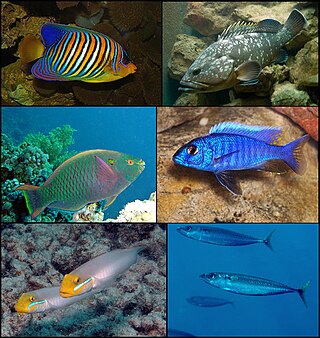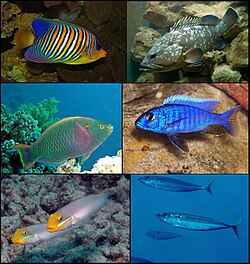Top Qs
Timeline
Chat
Perspective
Percomorpha
Clade of ray-finned fishes From Wikipedia, the free encyclopedia
Remove ads
Percomorpha (from Latin perca 'perch' and Ancient Greek μορφή (morphḗ) 'shape, appearance') is an extremely large and diverse clade of ray-finned fish. With more than 17,000 known species (including tuna, seahorses, gobies, cichlids, flatfish, wrasse, perches, anglerfish, and pufferfish) known from both marine and freshwater ecosystems, it is the most speciose clade of extant vertebrates.[1][2][3][4][5][6]
Remove ads
Evolution
Summarize
Perspective
Percomorpha are the most diverse group of teleost fish today. Teleosts, and percomorphs in particular, thrived during the Cenozoic era. Fossil evidence shows that there was a major increase in size and abundance of teleosts immediately after the mass extinction event at the Cretaceous-Paleogene boundary c. 66 Ma ago.[7] The oldest known percomorph fossils are of the early tetraodontiforms Protriacanthus and Cretatriacanthidae from the Santonian to Campanian of Italy and Slovenia.[8] A higher diversity of early percomorphs is also known from the Campanian of Nardò, Italy, and these also show some level of diversification into modern orders, with representatives of the Syngnathiformes and Tetraodontiformes known.[9] Possibly the oldest percomorph is Plectocretacicus from the Cenomanian of Lebanon, which may be a stem-tetraodontiform; however, some morphological analyses indicate that it shows similarities with non-percomorph groups.[8][10]

Taxonomy
Many of the orders placed in Percomorpha today were originally placed in an expanded Perciformes, hence many sources often referring to that order as the most diverse vertebrate clade. However, more recent studies have found such a placement to be paraphyletic, and many have thus been moved to their orders within Percomorpha.[6]
The Percomorpha are an extremely diverse group with at least 22 orders according to Eschmeyer's Catalog of Fishes.[11] Other authorities find a different number of orders depending on the classification used.
The following taxonomy is based on Eschmeyer's Catalog of Fishes (2025), with additional suborders based on other studies:[5][11]
- Clade Percomorpha
- Subseries Ophidiida
- Order Ophidiiformes
- Suborder Ophidioidei – cusk-eels, pearlfishes and allies (4 families) [12]
- Suborder Bythoidei – viviparous and false brotulas (2 families)
- Order Ophidiiformes
- Subseries Batrachoidida
- Order Batrachoidiformes – toadfishes (1 family)
- Subseries Gobiida
- Order Gobiiformes
- Suborder Apogonoidei (=order Kurtiformes sensu auct.) – nurseryfishes and cardinalfishes (2 families)
- Suborder Trichonotoidei – sand divers (1 family)
- Suborder Gobioidei – gobies, sleepers and allies (7 families)
- Order Gobiiformes
- Subseries Syngnatharia
- Order Syngnathiformes
- Suborder Dactylopteroidei – seamoths and flying gurnards (2 families)
- Suborder Mulloidei – goatfishes (1 family)
- Suborder Callionymoidei – dragonets (2 families)
- Suborder Syngnathoidei – seahorses, pipefish, trumpetfish, cornetfish and shrimpfishes (5 families)
- Order Syngnathiformes
- Subseries Pelagiaria
- Order Scombriformes
- Suborder Stromateoidei – medusafishes, driftfishes, butterfishes, squaretails, ariommas and allies (6 families)
- Suborder Scombroidei – mackerel, tunas, manefishes, pomfrets, cutlassfishes, bluefish, swallowers, ragfish and allies (10 families)
- Order Scombriformes
- Subseries Anabantaria
- Order Synbranchiformes
- Suborder Mastacembeloidei – freshwater spiny eels and earthworm eels (2 families)
- Suborder Indostomoidei – armored sticklebacks (1 family)
- Suborder Synbranchoidei – swamp eels (1 family)
- Order Anabantiformes
- Suborder Anabantoidei – gouramies and fighting fishes (3 families)
- Suborder Channoidei – snakeheads (2 families)
- Suborder Nandoidei – Asian leaffishes, chameleonfishes, and mudperches (3 families)
- Order Synbranchiformes
- Subseries Carangaria
- Order Carangiformes
- Suborder Centropomoidei – barracudas, lates perches, snooks and false trevally (4 families)
- Suborder Pleuronectoidei – flatfishes and threadfins (17 families)
- Suborder Toxotoidei – archerfishes and beachsalmons (2 families)
- Suborder Nematistioidei – roosterfish (1 family)
- Suborder Menoidei – moonfish and billfishes (3 families)
- Suborder Carangoidei – jacks, trevallies, pompanos, remoras, cobias and dolphinfishes (4 families)
- Order Carangiformes
- Subseries Ovalentaria
- Order Atheriniformes[5]
- Suborder Atherinopsoidei – Neotropical silversides (1 family)
- Suborder Atherinoidei – Old World silversides, rainbowfishes, priapumfishes and allies (10 families)
- Order Beloniformes[5]
- Suborder Adrianichthyoidei – ricefishes and buntingis (1 family)
- Suborder Belonoidei – sauries, needlefishes, halfbeaks and flyingfishes (5 families)
- Order Cyprinodontiformes
- Suborder Aplocheiloidei – Old and New World rivulines (3 families)
- Suborder Cyprinodontoidei – killifishes, pupfishes, splitfins, livebearers, lampeyes and four-eyed fishes (11 families)
- Order Cichliformes – cichlids, leaffishes and convict blenny (3 families)
- Order Mugiliformes – mullets and Asiatic glassfishes (2 families)
- Order Blenniiformes
- Unranked clades – dottybacks, roundheads, damselfishes, clownfishes, surfperches and jawfishes (6 families)
- Suborder Gobiesocoidei – clingfishes (1 family)
- Suborder Blennioidei – blennies (6 families)
- Order Atheriniformes[5]
- Subseries Eupercaria
- Order Perciformes
- Suborder Percoidei – perches, darters, seabasses, groupers, anthias, weeverfishes and duckbills (9 families)
- Suborder Notothenioidei – icefishes, toothfishes, Antarctic dragonfishes and allies (8 families)
- Suborder Scorpaenoidei – scorpionfishes, stonefishes, rockfishes, flatheads, searobins and allies (11 families)
- Suborder Cottoidei – sculpins, psychrolutes, snailfishes, sablefishes, greenlings, poachers, sandfishes, lumpfishes and allies (11 families)
- Suborder Gasterosteoidei – sticklebacks, Korean sandlance and tubesnouts (3 families)
- Suborder Zoarcoidei – eelpouts, wolffishes, pricklebacks, gunnels, prowfish and allies (14 families)
- Order Centrarchiformes
- Suborder Percalatoidei – Australian basses (1 undescribed family)
- Suborder Terapontoidei – grunters, sea chubs, flagtails, knifejaws, stripeys and allies (9 families)
- Suborder Centrarchoidei – freshwater sunfish, Chinese perches, oldwives, temperate perch, jutjaws and allies (7 families)
- Suborder Cirrhitioidei – hawkfishes, kelpfishes, marblefishes, fingerfins and trumpeters (5 families)
- Order Labriformes
- Suborder Labroidei – wrasses, parrotfishes, false scorpionfish and weed whitings (3 families)
- Suborder Uranoscopoidei – sandlances, stargazers, southern sandfishes, sandperches and torrentfish (5 families)
- Order Acropomatiformes (=Pempheriformes) – lanternbellies, sweepers, gnomefishes, wreckfishes, banjofish, oceanic basslets, armorheads and allies (20 families)
- Order Acanthuriformes – surgeonfishes, butterflyfishes, rabbitfishes, marine angelfishes, drumfish, grunts, ponyfishes, mojarras, snappers, temperate basses, spadefishes, porgies, moonyfish, tripletails, tilefish, scats, bigeyes, boarfishes and allies (30 families)
- Order Lophiiformes – anglerfish
- Suborder Lophioidei – goosefishes (1 family)
- Suborder Ogcocephaloidei – batfishes (1 family)
- Suborder Antennarioidei – frogfishes and handfishes (1 family)
- Suborder Chaunacoidei – sea toads (1 family)
- Suborder Ceratioidei – deep-sea anglerfish (11 families)
- Order Tetraodontiformes
- Suborder Triacanthoidei – spikefishes and triplespines (2 families)
- Suborder Tetraodontoidei – pufferfishes, porcupinefishes, ocean sunfishes and allies (4 families)
- Suborder Balistoidei – boxfishes, filefishes, triggerfishes and allies (4 families)
- Order Perciformes
- Incertae sedis:
- Subseries Ophidiida
Phylogeny
External relationships
The two cladograms below are based on Betancur-R et al., 2017.[5] Percomorphs are a clade of teleost fishes. The first cladogram shows the interrelationships of percomorphs with other living groups of teleosts.
| Teleostei |
| ||||||||||||||||||||||||||||||||||||||||||||||||||||||||||||||||||||||||||||||||||||||||||||||||||||||
Internal relationships
The following cladogram shows the evolutionary relationships of the various groups of extant percomorph fishes:
| Percomorpha |
| |||||||||||||||||||||||||||||||||||||||||||||||||||||||||||||||||||||||||||||||||||||||||||||||||||||||||||||||||||||||||||||||||||||||||||||||||||||||||||||||||||||||||||||||||||||||||||||||||||||||||||||||||||||||||||||||||||||||||||||||||||||||||||||||||||||||||||||||||||||||||||||||||||||||||||||||||||||||||||||||||||||||||||||||||||||||||||||||||||||||||||||||||||||||||||||||||||||||||||||||
Remove ads
References
Wikiwand - on
Seamless Wikipedia browsing. On steroids.
Remove ads









